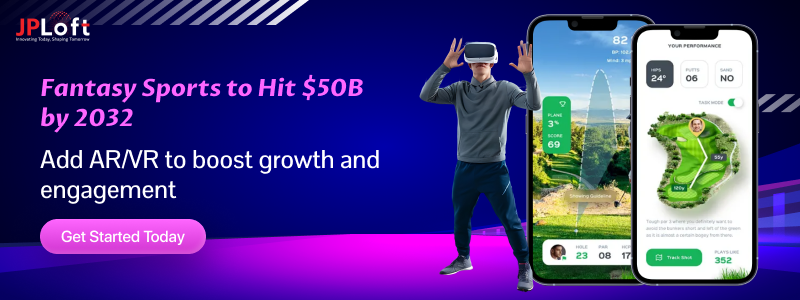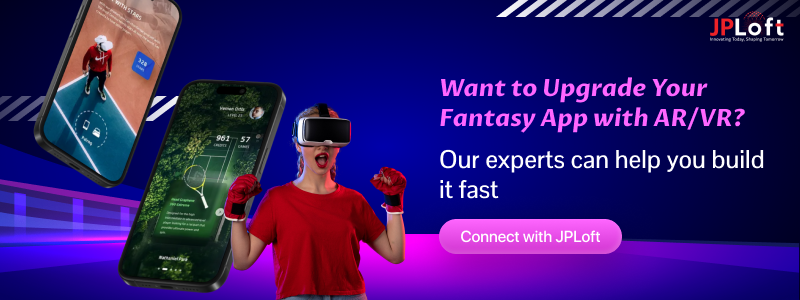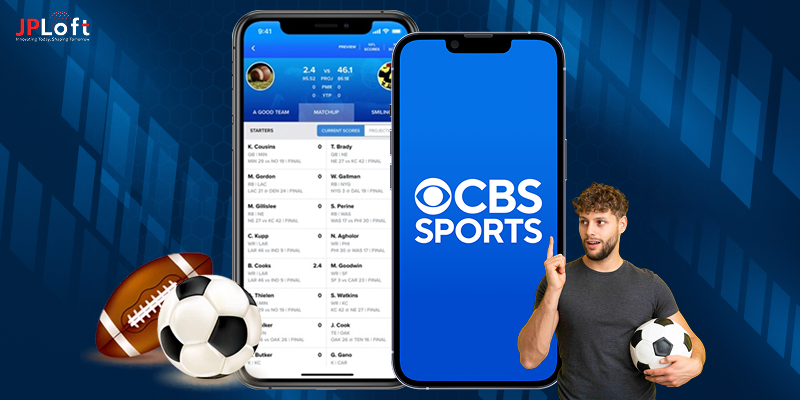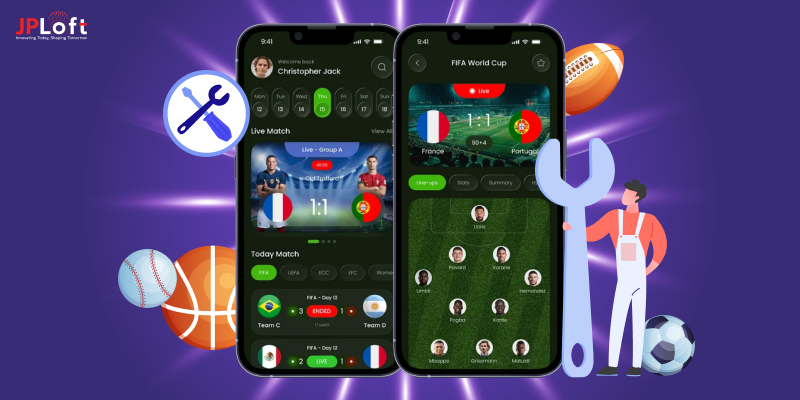Key Takeaway
AR/VR in fantasy sports apps transforms static score tracking into immersive experiences like virtual stadiums, live overlays, and interactive draft rooms.
These technologies boost fan engagement by making fantasy leagues more social, visual, and emotionally connected.
AR and VR solve retention challenges, keeping users active through gamified training, VR watch parties, and AR leaderboards.
Investors benefit from new revenue streams via premium VR seats, AR-sponsored contests, and branded digital collectibles.
The future of fantasy sports lies in merging AR, VR, and AI for hyper-personalized, predictive, and interactive gaming.
Partnering with JPLoft gives entrepreneurs the expertise to design AR/VR-powered fantasy sports apps that attract users and scale globally.
"The future belongs to those who prepare for it today." – Malcolm X
Fantasy sports apps have already transformed how fans engage with their favorite games, but the next leap forward comes from immersive technologies. With markets for both fantasy sports and AR/VR growing rapidly, entrepreneurs and investors are now asking: What is the role of AR/VR in fantasy sports apps?
The answer lies in how these technologies elevate the user experience. AR overlays deliver real-time stats, heatmaps, and projections on any screen, while VR creates virtual stadiums, draft rooms, and watch parties that replicate real-life excitement. Together, they turn passive score tracking into active, engaging, and highly social experiences.
Beyond user engagement, AR/VR unlocks new monetization models and strengthens loyalty. In short, AR and VR are no longer add-ons; they are essential pillars shaping the future of fantasy sports apps.
All About Fantasy Sports Apps and Their Market
Fantasy sports apps are virtual portals where players build virtual teams composed of actual athletes. The idea is straightforward: players gain points as a result of the real-life performance of their selected players in live games.
The apps convert passive sports watching into an immersive activity, allowing fans to compete against friends or strangers in leagues, competitions, or daily games. Emerging from conventional fantasy leagues, newer apps introduce sophisticated elements such as real-time stats, artificial intelligence-powered suggestions, and immediate winnings.
Essentially, fantasy sports apps blend sports passion, strategy, and technology, heightening the enjoyment of watching games, competitiveness, and a rewarding experience.
Now, let’s learn a bit about the fantasy sports market statistics, below.
-
As per CMI, the fantasy sports market size was USD 19.1 billion in 2022, while this valuation is anticipated to reach USD 50.4 billion by 2032.
-
The fantasy sports market size was valued at USD 30.4 billion in 2023, and is poised and is expected to grow from USD 34.08 billion in 2024 to USD 84.98 billion by 2032, that is growing at a CAGR of 12.1%, during the forecast period of 2025 to 2032.
-
Additionally, the global fantasy sports market size was valued at USD 32.21 billion in 2024, and is expected to grow from USD 36.75 billion in 2025, which is further projected to reach USD 105.58 billion by 2033.
-
The North American fantasy sports market size reached USD 13.09 billion in 2025, and is projected to climb to USD 24.23 billion by 2030, that is reflecting a CAGR of 13.10% CAGR.
-
The AR and VR market size was valued at USD 22.12 billion in 2024, and is expected to reach USD $96.32 billion by 2029, growing at a CAGR of 34.2% during the forecast period of 2024 to 2029.
-
Along with this, the global AR and VR headsets market size was estimated at USD 12.46 billion in 2024, and is anticipated to reach around USD 261.92 billion by 2034, growing at a CAGR of 35.60% between 2025 to 2034.
Based on these market trends, let’s get ahead with evaluating the concept of AR/VR in fantasy sports apps in the next section.
What is AR/VR in Fantasy Sports Apps?
Let’s first evaluate the meaning of AR and VR.
Augmented reality (AR) is a technology that overlays digital elements, including images, stats, graphics, or 3D models, within the real-world environment through devices such as smartphones, AR glasses, and tablets.
On the other hand, Virtual reality (VR) is a fully immersive technology that builds a computer-generated environment where users can interact as if they are practically present.
When it comes to learning AR/VR in fantasy sports apps, these technologies do transform how fans experience sports beyond traditional screens. Together, AR and VR elevate the fantasy sports concept by shifting it from a data-driven interface to an experiential platform.
The implementation of AR and VR does allow fans to interact more personally with games, and does provide an immersive, social, and emotionally charged experience for users.
Want to know more about AR/VR in fantasy sports apps? Let’s evaluate its role in the following section.
Role of AR/VR in Fantasy Sports Apps
When you develop a fantasy sports app, it's essential to include the latest technologies for enhancing the sustainability of the app in the competitive landscape.
Now, let’s get ahead to learn the role of AR/VR in fantasy sports apps in this section.
1. Immersive Player Analysis and Statistics Visualization
Fantasy sports enthusiasts can examine player statistics in three-dimensional space, allowing them to interact with data models that display performance metrics, injury reports, and historical trends.
Users can walk around virtual representations of player statistics, comparing multiple athletes side by side in an engaging environment. This spatial approach to data analysis helps managers make more informed decisions when building their fantasy rosters.
The technology transforms traditional spreadsheets into interactive experiences that feel more intuitive and engaging.
2. Virtual Stadium Experience and Live Match Viewing
VR technology transports fantasy sports players directly into virtual stadiums where they can watch live games from premium viewing angles.
Users can select different camera perspectives, including courtside or field-level views that would typically be unavailable to regular viewers.
This creates a sense of presence and excitement that deepens emotional investment in fantasy team performance. The immersive viewing experience makes following real-time games more thrilling while tracking fantasy points simultaneously.
3. Interactive Draft Room Experience
AR and VR in fantasy sports apps can recreate the traditional draft in a virtual environment where participants gather as avatars around a digital draft board.
Users can see real-time picks, discuss strategies through spatial audio, and experience the competitive atmosphere of draft day from their homes.
The technology adds social elements like gestures, reactions, and virtual celebrations that replicate in-person draft parties. This makes remote drafting feel more connected and memorable compared to standard web-based interfaces.
4. Enhanced Player Scouting and Team Formation
Fantasy managers can use AR overlays on their mobile devices to view player information when watching games on television or in person at stadiums.
Pointing a device at the screen or field reveals real-time fantasy points, ownership percentages, and projected performance data. This seamless integration of digital information with live action helps users make quick waiver wire decisions and lineup adjustments.
Thus, AR/VR in fantasy sports apps bridges the gap between watching sports for entertainment and managing fantasy teams strategically.
5. Gamified Training and Strategy Simulation
VR environments allow fantasy sports players to simulate game scenarios and test different lineup combinations in virtual matches before committing to actual decisions.
Users can visualize how their team might perform under various conditions, experimenting with different strategies in a risk-free setting.
This hands-on approach to team management makes strategic planning more engaging than simply reviewing numbers on a screen. The gamification aspect increases user engagement and time spent within the fantasy sports platform.
6. Social Interaction and League Engagement
Virtual reality in fantasy sports apps creates shared spaces where league members can gather for weekly matchups, trash talk, and celebrate victories in customized virtual environments.
AR in fantasy sports apps enables users to project leaderboards, matchup details, and team comparisons onto real-world surfaces during social gatherings.
These technologies strengthen community bonds among league participants who may be geographically separated. The social dimension transforms fantasy sports from a solitary activity into a collaborative and competitive group experience.
7. Real-Time Augmented Scoreboards and Notifications
AR technology overlays live fantasy scores and player performance updates directly onto the user's field of vision through smart glasses or mobile devices.
Users receive immersive notifications about touchdowns, home runs, or significant plays that affect their fantasy standings without interrupting their current activities. This constant connection to fantasy performance keeps users engaged throughout game days.
The hands-free nature of AR notifications makes monitoring multiple games and players more convenient and less intrusive.
8. Virtual Trophy Rooms and Achievement Galleries
Fantasy sports apps can create personalized VR spaces where users display their championship trophies, season highlights, and memorable victories in three-dimensional galleries.
Participants can invite friends to tour their virtual trophy rooms, sharing stories about dramatic comebacks and successful seasons. This permanent record of fantasy achievements adds lasting value beyond temporary seasonal rankings.
The visual representation of success motivates continued participation and creates memorable experiences that extend beyond simple league victories.
To successfully implement advanced AR/VR features like immersive draft rooms or real-time stat overlays, partnering with a trusted mobile app development company in the USA can ensure the right blend of innovation, scalability, and compliance for your fantasy sports app.
Now, following the complete role of AR/VR in fantasy sports apps, let’s learn about how to add this technology to the app in the proceeding section.
Features of AR/VR for Fantasy Sports Apps
When you implement AR/VR in fantasy sports apps, it's essential to look for the key features for enhancing the user experience in this competitive environment.
With the effective implementation of fantasy sports app features, you can successfully win the heart and trust of the target audiences.
And, when it comes to AR/VR, let’s learn the list of different types of AR/VR features to implement in the fantasy sports apps, here:
► Immersive Match Viewing with Live Overlays
Combine AR stat overlays with VR stadium experiences.
Fans can watch matches in a VR stadium and view real-time player stats and fantasy points as AR layers.
This makes for a "watch + play" atmosphere, enhancing the fantasy experience.
► 3D Player Cards and Virtual Draft Rooms
Apply AR to overlay 3D player cards for team construction.
Transition into VR draft rooms where users engage, bargain, and select players in a simulated setting.
This blend makes lineups events instead of mere data input.
► Interactive Match Replays and Real-Time Heatmaps
AR heatmaps present player movement, position, and performance metrics on the user's screen.
VR highlight theaters enable users to enter replays with multi-angle views and immersive commentary.
They improve both strategic choices and entertainment value together.
► Social Watch Parties with AR Filters & VR Lounges
Fans can share matches in VR lounges with friends.
Meanwhile, social sharing remains fun and entertaining through AR filters (fan banners, team jerseys, live reaction effects).
This aspect enhances community growth, retention, and word-of-mouth promotion.
► Gamified Contests & AR/VR Mini-Games
Create AR-based contests (e.g., score predictions with interactive graphics).
Combine them with VR micro-tournaments where players compete in brief contests within a virtual arena.
This maintains interest even between major fantasy contests.
► Branded Sponsorships and Virtual Merchandise
AR advertisements can be shown as live overlays during games.
VR environments can have branded booths or enable users to purchase team jerseys, collectibles, or NFTs.
Monetization becomes more engaging while remaining user-friendly.
► AR Onboarding + VR Tutorials
AR tutorials walk newbies through lineup setup in real-time pop-ups.
VR "training rooms" can simulate fantasy drafts or demonstrate scoring functions.
This minimizes the learning curve and retains new users.
After learning about these features, you can successfully proceed to learn the effective strategies for adopting AR/VR in fantasy sports apps in the given section.
How to Implement AR/VR in Fantasy Sports Apps?
Along with this, to start an online fantasy sports business, you should be aware of effective strategies.
Similarly, for implementing ARVR in the fantasy sports apps, you should know the right process and prompt steps that can help you earn the trust of the users.
But the question is, “How to implement AR/VR in fantasy sports apps?”
Let’s learn the steps in this section.
Step 1: Identify the Role of AR/VR in Fantasy Sports Apps
Before diving into development, outline the specific role of AR/VR in fantasy sports apps.
Ask: Should AR enhance live stat overlays, or should VR recreate a stadium environment?
Clarifying this vision ensures that augmented reality in fantasy sports apps focuses on engagement (like 3D team lineups) while virtual reality in fantasy sports apps builds immersive features (like VR draft rooms).
A clear role definition helps align user needs with your app’s core objectives.
Step 2: Choose the Correct AR/VR Tech Stack
Technology selection makes or breaks deployment. For augmented reality in fantasy sports apps, ARKit (iOS), ARCore (Android), and Vuforia are some of the favorites. For virtual reality in fantasy sports apps, Unity, Unreal Engine, and WebVR are the leaders.
Live sports APIs for real-time player statistics and data visualization are also needed. Scalable back-end systems and GPU-optimized rendering help AR/VR features not impact gameplay. The fantasy sports app tech stack should include such a technology so that you can scale up or integrate AR-VR further when required.
Step 3: Design Immersive User Experiences
More than data, users demand interactive fun. AR can overlay live statistics, heatmaps, or 3D player cards into a user's space, whereas VR can place them inside fantasy draft rooms or 360° replay theaters.
With intuitive fantasy sports app design as the focus, you can make complicated data simple yet fun visuals. This is where the application of AR/VR in fantasy sports apps transcends technology, creating an emotional attachment that makes users stick.
Step 4: Construct Scalable and Real-Time Infrastructure
Speed and precision are what drive AR/VR. Merging cloud servers, CDN delivery, and fast data feeds keeps match stats, overlays, and VR environments in real-time.
With fantasy sports apps reaching their highest usage during live tournaments, scalability is critical.
Without scalability, even the most sophisticated AR/VR in fantasy sports apps will experience slowdown, which destroys trust and retention.
Step 5: Test Across Devices and Optimize Performance
Not all users have a high-end VR headset, so multi-device testing is essential. Make augmented reality in fantasy sports applications seamless across smartphones, while VR experiences provide smooth frame rates on compatible hardware.
You should go for the mobile app testing landscape to test every function. Optimize for battery life, low latency, and accessibility items such as color-blind AR overlays or voice-controlled VR. This makes everything inclusive without sacrificing performance.
Step 6: Combine Monetization with AR/VR Features
AR/VR isn't only for engagement; AR/VR is a money maker. AR contests with sponsored overlays, premium "stadium seats" in VR, and interactive sponsorships can launch new monetization avenues.
Packaging them as premium tiers or freemium upgrades underscores the commercial potential of AR/VR within fantasy sports apps. Done well, monetization comes across as organic and improves the user experience rather than interrupting it.
Step 7: Launch, Get Feedback, and Continue to Innovate
Roll out AR/VR capabilities in phases, begin with beta releases, collect player feedback, and make adjustments. Emphasize how your application of augmented reality to fantasy sports apps (for lineups and stats) and virtual reality to fantasy sports apps (for drafts and live replays) makes your platform stand out.
Then, extend innovation further with AI-facilitated predictions, NFT integrations, or Web3-based ownership schemes. Ongoing improvement is what keeps your fantasy sports app up-to-speed in a competitive arena. You can partner with the leading mobile app maintenance services to enable continued improvement.
You might face challenges while adopting and implementing AR/VR in fantasy sports apps. However, to mitigate them is the key to increasing user engagement. Let’s learn them in the given section.
Challenges in Integrating AR/VR in Fantasy Sports Apps
Evaluating the key challenges while building a fantasy sports app can help in estimating the potential errors that might result in a major mistake in the future.
Let’s learn about the list of key challenges in integrating AR/VR in fantasy sports apps.
1] High Development and Hardware Expenses
Developing AR/VR for fantasy sports apps comes with the need for sophisticated tools, 3D modeling, and intensive back-end infrastructure. In addition to that, VR headsets and AR-compatible devices are not yet widely accepted, so it is costly to produce and scale these features.
2] Real-Time Data Precision and Latency
Syncing augmented reality in fantasy sports apps and virtual reality in fantasy sports apps with actual match data is one of the most challenging tasks. Any lag or discrepancy in stats can annoy users and shatter trust, particularly when there is money and competition at stake.
3] Device Compatibility and Performance
Not everyone owns the newest smartphones or VR headsets. Smooth rendering of AR/VR functionalities within fantasy sports apps across various devices, without battery consumption or crashes, is a significant technical challenge for developers.
4] User Adoption and Accessibility
Though AR and VR are thrilling, most users are still inexperienced with immersive technologies. To get them to adopt AR/VR in fantasy sports apps, it needs intuitive onboarding, accessible pricing, and accessibility features to facilitate easier adoption.
5] Regulatory and Compliance Issues
Fantasy sports apps are already under scrutiny in most markets. Incorporating AR/VR features within fantasy sports apps, particularly VR games involving real-money betting, raises additional compliance issues on gaming rules, licensing, and fair play.
6] Security and Privacy Issues
Gathering and rendering real-time information in augmented reality in fantasy sports games poses threats such as data leaks, fraud, or cheating. Developers have to lock down data feeds, thwart manipulation, and safeguard user identity in AR and VR environments.
Other Future Trends to Watch While Adopting AR/VR in Fantasy Sports Apps
Learning about the fantasy sports future trends provides benefits like developing data analysis and strategic decision-making skills, and gaining a deeper understanding of sports.
For the entrepreneurs and the investors, the future trends will help to define the possibility to invest and grow with the changing demands of the users..
Let’s evaluate the future trends of adopting AR/VR in fantasy sports apps below.
A] AI-Augmented AR/VR Experiences
Merging AI with AR/VR in fantasy sports apps will personalize predictions, player suggestions, and stat overlays. Picture AR delivering insights tailored to your past plays, or VR modeling potential outcomes before you seal a roster.
B] Web3, NFTs, and Virtual Ownership
Fantasy sports apps are heading towards virtual reality in fantasy sports apps that feature NFT-based collectibles and metaverse integration. Users may own virtual jerseys, player cards, or seats in a VR stadium, providing digital assets with real-world value.
C] AR-Based Social Engagement
Look for greater emphasis on augmented reality in fantasy sports apps through live fan filters, AR celebrations based on teams, and AR chatrooms. This enhances social engagement, transforming fantasy sports into a community experience rather than contests.
D] VR-Driven Immersive Tournaments
In the future, VR in fantasy sports apps will create massive virtual tournaments where users participate in contests within virtual stadiums. The trend will converge esports, live fantasy competitions, and immersive fan entertainment.
E] Micro-Contests with Real-Time AR Overlays
Briefer contests tied to specific periods or plays will be combined with AR/VR on fantasy sports apps. AR will show predictive probabilities of wins, while VR may enable fans to experience "next-play" situations in real time.
F] Integration with Live Broadcasts and OTT Platforms
Fantasy apps will bring AR stats overlays directly into live broadcasts of sports. VR versions will be synchronized with OTT platforms, so users will not need to change devices in order to watch games and maintain fantasy teams, as engaging play goes mainstream.
Are you ready to go for AR-VR app development? Well, if you are confused about whether it will be successful or not, then the following list of case studies can be helpful.
Case Studies: How Top Fantasy Sports Apps Have Adopted AR-VR
The following are some case studies, type observations (from public reports at hand) on how leading fantasy sports apps are starting to embrace AR/VR trends, what they've done already, what they're testing, and what indications there are of upcoming action.
Let’s learn about the top fantasy sports apps and evaluate how they are using AR-VR technologies in the present landscape.
1. DraftKings
DraftKings has publicly explored plans to incorporate AR features for fantasy drafts and develop VR-driven immersive gaming environments.
For instance, one analysis points out DraftKings is "entering … the field of blending immersive gaming worlds with bet placement capability" in VR.
It hasn't deployed full VR stadiums yet (according to public sources), but the signs indicate they consider virtual reality within fantasy sports apps a future differentiator.
The action is sensible: DraftKings is already a leader in innovation and is most likely applying AR/VR to enhance engagement, retention, and monetization in its core contests. If you are planning to develop an app like DraftKings, you should look forward to implementing AR/VR technology.
2. FanDuel
FanDuel is mentioned in immersive-technology conversations as one of the early movers incorporating AR overlays on real-time player statistics in their fantasy/sports betting platform.
Certain AR/VR concept articles include FanDuel as providing "real-time player stats with AR overlays and VR-based game simulation."
These are probably experiments or conceptual elements (not yet fully rolled out), most AR/VR implementations within fantasy apps remain in pilot or prototype status.
Adopting AR/VR can increase your cost to develop an app like FanDuel; however, it will provide you an assistance to engage key users.
3. ESPN / Yahoo / CBS / Others
ESPN's fantasy sport franchises are cited within articles regarding AR/VR adoption, specifically the application of AR overlays over live games to present player statistics and fantasy points superimposed on broadcasts.
Few development pitches propose that ESPN / Yahoo/sibling sports sites could lead in embracing AR-enriched viewing layers as a step towards full VR immersion.
In fantasy sports app guidebooks, augmented reality incorporation in fantasy sports apps is offered as a plan to enhance engagement.
If you create an app like ESPN fantasy sports, you should look at the types of technologies this app uses to sustain in the competitive environment.
What These Case Studies Tell Us (so far)?
Let’s learn about what these case studies have taught us to learn so far.
► Begin with AR Before VR
Most top apps are testing AR overlays first (live data, highlight details) since it's less expensive, simpler to deploy, and less hardware-bound. VR is the follow-on.
► Draft/contest Features Are Up Front
Fantasy drafts and contest entry streams are areas where AR/VR can introduce novelty without subverting core mechanics. DraftKings is one of those concentrating here.
► Hybrid Monetization and Engagement Applications
AR/VR is being considered in most cases as a premium layer, i.e., paying for special visual modes or immersive views.
► Experimental, not Mainstream Yet
AR/VR's role in fantasy sports apps is still largely in exploratory or prototype stages among leading apps. There are very few widely known large-scale deployments.
► Data + Infrastructure Readiness is Paramount
Since fantasy sports are dependent on extremely accurate real-time data, such apps need to establish strong pipelines prior to adding AR/VR.
Connect with the Experts of JPLoft and Integrate AR/VR in Fantasy Sports Apps
Bringing AR and VR into fantasy platforms is no longer a futuristic idea; it’s quickly becoming a necessity for apps that want to stand out.
From immersive stadium experiences to real-time AR stat overlays, these features can transform user engagement and open new monetization opportunities.
But implementing them requires more than just technical know-how; it demands expertise in both fantasy sports logic and immersive technologies.
That’s where JPLoft steps in. Recognized as a trusted fantasy sports app development company, JPLoft has the experience to design, build, and scale AR/VR-powered solutions tailored to your audience.
Whether you want to introduce interactive 3D drafts, VR-driven watch parties, or AR tutorials for beginners, our team ensures smooth integration with robust infrastructure and future-ready innovation.
Partner with JPLoft, and leap into a more engaging, profitable, and immersive fantasy sports experience.
Conclusion
AR/VR in fantasy sports apps is no longer a buzzword; it’s shaping the future of how fans engage with games. From immersive draft rooms to interactive match overlays, these technologies redefine user experience, boost retention, and unlock fresh monetization channels.
Market statistics prove both fantasy sports and AR/VR industries are growing rapidly, creating a powerful synergy for entrepreneurs and investors. The challenges, cost, compliance, and adoption are real but solvable with the right expertise.
Partnering with leaders like JPLoft ensures innovation meets execution, empowering you to build fantasy sports platforms that are immersive, competitive, and future-ready.
FAQs
They transform static gameplay into immersive, interactive experiences, enabling real-time stats, VR stadiums, and gamified strategies for deeper engagement.
Beyond entertainment, AR/VR makes fantasy sports more strategic, social, and rewarding, keeping users loyal and increasing session time.
AR overlays live stats, player data, and predictions onto screens, helping users make informed lineup decisions while boosting entertainment value.
It bridges the gap between watching live matches and managing teams, making every play feel directly connected to the fantasy outcome.
VR creates immersive stadiums, draft rooms, and watch parties, making fantasy participation more social, interactive, and emotionally connected.
By replicating real-world experiences digitally, VR strengthens user engagement and can open premium tiers for monetization opportunities.
High development costs, real-time data accuracy, device compatibility, compliance, and user adoption barriers are common implementation challenges.
Addressing these challenges requires strong infrastructure, intuitive onboarding, and collaboration with experts to ensure scalability and user satisfaction.
Yes, monetization opportunities include premium VR seats, AR-sponsored contests, branded experiences, and virtual merchandise, driving new revenue streams.
These features also increase retention and open sponsorship channels, making the investment worthwhile in competitive markets.













Share this blog